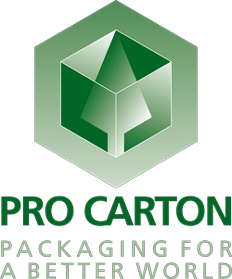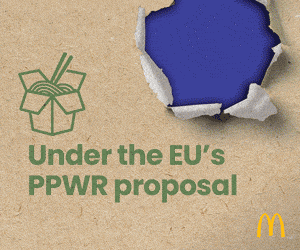McDonald’s EVP and global chief impact officer on EU’s PPWR proposals… and the Kearney report that reveals their anticipated impact on environment, economy, food safety and consumers.
Last time, I said we wanted to stimulate a debate around PPWR — I think I can safely say that has happened. And that’s a good thing. However, for McDonald’s, and many of our partners and competitors from the informal eating-out sector (IEO), we still believe that unintended consequences of the current PPWR proposal mean it will be bad for the environment, the economy, food safety — and for consumers.
Put simply — we believe a mix of packaging solutions is the only way to achieve PPWR’s broader objectives.
We base this on independent research by global management consulting firm Kearney in the report, No Silver Bullet, and on current market experience. Put simply — we believe a mix of packaging solutions is the only way to achieve PPWR’s broader objectives. At McDonald’s, we are on a journey to help implement and accelerate solutions to keep waste out of nature and valuable materials in use. This is why, in the months since I was last in Brussels, we and our suppliers have continued our commitment to invest in practices and innovations that we believe will tackle the issues PPWR is trying to address head on.
A key strategy is transitioning away from single-use, virgin fossil fuel-based plastics – the vast majority of packaging used in European restaurants is paper based and sourced from Europe. Another key strategy is recycling, which is why we’ve been implementing systems across Europe for many years. Indeed, since early this year, 355 of our restaurants in Poland operate within a closed loop waste management system. McDonald’s Poland works jointly with paper recycler Miklan-Ryza on the development and implementation of proprietary technology to fully recycle food-contaminated paper packaging, including plastic-lined paper cups. By the end of 2024, we plan to expand the program to all our Polish restaurant parking lots to ensure packaging thrown away near restaurants is also collected for recycling.
A key strategy is transitioning away from single-use, virgin fossil fuel-based plastics.
A similarly integrated public—private partnership has operated in Italy for several years in collaboration with Comieco (National Consortium for the Recovery and Recycling of Cellulose-based Packaging) and is constantly being improved. It means McDonald’s packaging can enter the paper recycling stream and be effectively recycled together with other paper waste volumes. We are also investing in a national public awareness campaign with another partner, Altroconsumo, to show customers that through small daily choices they can make a big difference. Comieco will shortly release an assessment of collection and effective recycling rates of our packaging at McDonald’s Italy, and we are confident it will show that recycling of fiber-based packaging works at scale.
For years, McDonald’s, our franchisees, partners and competitors in the IEO sector have been innovating and investing in fiber packaging and recycling solutions, but it is also what policy makers have been promoting successfully for the last 30 years since the EU’s original Packaging and Packaging Waste Directive . Now, PPWR risks throwing that all away and — by mandating reusables — creating more plastic in Europe. Plastic that won’t come from Europe. Wouldn’t it be better to continue eliminating plastic, investing in our existing recycling infrastructures, and helping consumers make the right choices? There is also excess recycling capacity in Europe, so we should use it.
Wouldn’t it be better to continue eliminating plastic, investing in our existing recycling infrastructures, and helping consumers make the right choices?
Of course, the idea of reusing something over and over again seems the obvious solution — but it’s not so simple. Indeed, the very word ‘reusables’ is, in my opinion, misleading; it implies something will be used an infinite number of times. In reality, this is not the case. For reusable packaging to have a positive impact on the environment, it needs to be reused 50 to 100 times to make it environmentally preferable to a single-use paper cup, according to Kearney. Re-use might be an appropriate solution for other sectors of the economy, but current in-market experience across our restaurants suggests there are serious unintended consequences for the environment as a result of PPWR. For example, in the Netherlands where we offer reusable cups with a refundable 1 EUR deposit, alongside single-use cups with a surcharge (as required by law), we still see fewer than 5 percent of customers choosing reusables, and only 25 percent are returned. In Germany, fewer than 2 percent of customers choose reusables; and only 40 percent are returned despite a deposit of 2 EUR per item. That means on average the same cup is not even used twice. Two real-life examples where reuse is falling far short of its intended impact.
In France, where certain packaging items are mandated as reusables for dine-in only and not intended to leave the restaurant, we are not achieving the desired numbers of reuses to have a positive environmental impact over single-use. The items are used fewer than 29 times on average — far from Kearney’s 50-100 times. That’s because a considerable number of customers are removing them from the restaurants or throwing them away.
This means reusable use-cases as mandated by PPWR will lead to a sharp increase in plastic materials in Europe according to the independent Kearney report, No Silver Bullet. Reuse targets proposed in PPWR will create four times the amount of plastic packaging waste for dine-in, and 16 times for takeaway.
The production of reusable plastic packaging, and its washing and transportation, also requires more energy, resulting in increased greenhouse gas emissions. The Kearney study shows that a shift to 100 percent reusables by 2030 would increase emissions by up to 50 percent for dine-in and up to 260 percent for takeaway.
There are other serious unintended consequences of PPWR:
Reusables also need to be washed after every use. For an industry like ours, this relocates water demand from a small number of single-use fiber packaging production locations to all restaurant locations across Europe, many of which are in areas of higher water scarcity. PPWR would put Europe’s water infrastructure under even more stress. The production of reusable plastic packaging, and its washing and transportation, also requires more energy, resulting in increased greenhouse gas emissions. The Kearney study shows that a shift to 100 percent reusables by 2030 would increase emissions by up to 50 percent for dine-in and up to 260 percent for takeaway.
All this brings me to why I visited Brussels again — we and others in the IEO sector have managed to stimulate a valuable debate. But as time pressure builds ahead of next year’s elections, it’s more important than ever to remind everyone that a rush to a solution for a complicated situation will only make the problem worse. Europe has a history of compromise when it comes to meeting its biggest challenges, and I see every reason why this should be the case for PPWR. All options should be part of the solution — because there really is no silver bullet when it comes to solving Europe’s packaging problem.




